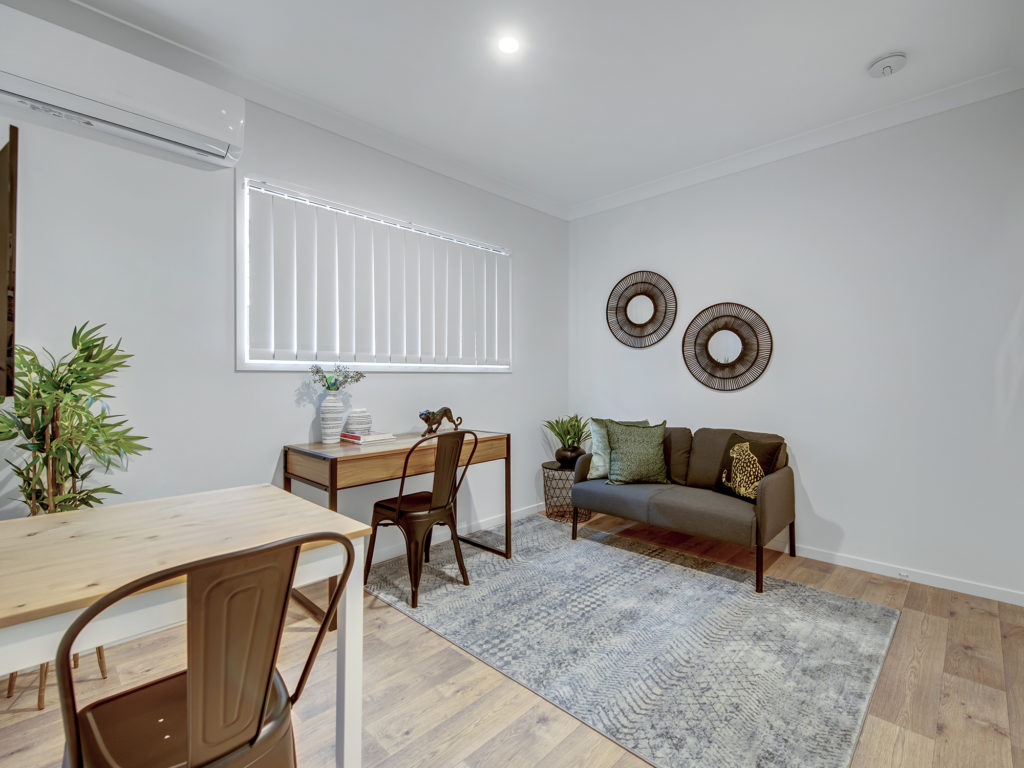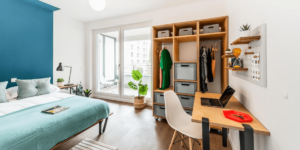12 Unbreakable Design Rules for Living in a Small Home
By Georgia Madden. As seen in Houzz, October 29, 2021.
1. Consider your priorities
When designing a small home, start by considering your priorities and how you want to live and function in the space. For example, do you need room to exercise inside? An area to work from home? Will you have guests to stay? Are you into cooking or will you more likely eat takeaway food?
All these things will impact the amount of space you allocate to each area and help you design for maximum functionality.

2. Use mirrors
Wilson says:
Mirrors can work magic in a small space. Hang them on the wall or prop them on the mantlepiece or floor (firmly secured) and you’ll find that they bounce the light around, making the room feel brighter and enhancing the sense of space.
Another tip is to position a mirror opposite a window with views and you’ll instantly bring the outside in.
Ian Ugarte, founder of Invida, a company specialising in micro-apartments, says:
3. Position the biggest item first
In a small bedroom, for example, your first decision should be where to locate the bed as this will dictate where the smaller items of furniture should go, such as freestanding storage and an armchair. In the living area, begin by choosing the position of the sofa or sofas, then work the coffee table, side table and any storage around it (or them).
Starting with the main ‘hero’ pieces in a room will also determine where the television should go, which should generally be opposite the bed or sofa.

4. Storage is key
Wilson says:
Clutter and mess quickly pile up in a small property, so it’s important that everything has a home. Look for storage opportunities everywhere; shelving units with cubes, storage boxes and furniture that does double duty as storage, such as gas-lift beds, storage ottomans and the space at the top of cabinetry or under beds. The key is to conceal items neatly, while using all available space – this is practical but will avoid a messy look.
To maximise storage in a living area, dining room or bedroom, select furniture such as a buffet, chest of drawers and bedside tables over smaller units without storage. Use baskets, pretty boxes or cute tubs to store smaller bits and pieces that easily get lost.


5. Prioritise outdoor connection
Ugarte says:
Having an external space can completely transform a small home, giving you access to light, fresh air and an additional usable room.
Where possible, create a connection between the interior and exterior of your home with sliding or bi-fold doors. Sliding doors make the best use of space as they open flat rather than protruding into your outdoor area. They can also be easier and more cost-effective to install as they are bottom-mounted rather than top-mounted like bi-folds, which can require extra structural support.
Depending on size and set-up, you can expect to pay somewhere between about $4,000 and $7,000 to install sliding exterior doors.
6. Consider how noise travels
Ugarte says:
Noise is one of those things many people aren’t aware of until they move into a home, and televisions are generally the main culprit. Always look to install a television on an external wall or one that is facing away from bedrooms so you don’t disturb other people living in your home.
SMALL SPACES can be BIG EARNERS. Find out how investors are earning 2-3 x typical rents through co-living micro-apartments in our success stories HERE.

7. Have clear sightlines
Ugarte says:
Having free-flowing space allows the eye to travel right through a small room, making it appear more spacious. Plus, it also means you can move more comfortably through the area. Another bonus is that it allows natural light to filter through, which makes any room, whatever its size, feel more open and welcoming.
Avoid cluttering up rooms with too much furniture. Seek out pieces with low backs that won’t block sightlines, and position furniture in zones – dining, relaxing, working – so that you can move freely throughout.
8. Scale down furniture
Wilson says:
Choose compact versions of standard-size furniture to enhance space and circulation in your small home. Think narrow sofas, low-backed armchairs, slim sofas and ensemble beds rather than beds with heavy frames.

9. Use vertical space
Wilson says:
To add visual breathing space to a small home, keep horizontal surfaces as clear as possible and use vertical space where you can. For example, use wall space for storage and display, such as tall bookshelves, floating shelves or display niches.
10. Choose adaptable furniture
Ugarte says:
Flexible and multi-use furniture can be a lifesaver in a small abode, allowing you to get more from every room.
In a bedroom, consider a Murphy bed that folds away so you can use the space as a study or a second living area during the day. In the living room, consider a long bench that can be used for either seating or an extra surface for display or storage.
A drop-down table in the kitchen, particularly one with storage drawers at the centre, can give you dining space for four to six people, plus storage, then fold away when not in use.

Your turn
What’s the one thing you swear by for making a small space sing? Tell us in the Comments below.
Want to learn more about how you can invest in co-living micro-apartments? INVIDA creates custom co-living properties for investors that want positive cash flow returns. Click HERE for more.





